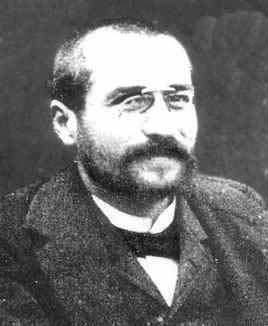<Back to Index>
- Mathematician Jules Richard, 1862
- Writer Miguel Torga (Adolfo Correia da Rocha), 1907
- Shogun of the Tokugawa Shogunate Tokugawa Iemitsu, 1604
PAGE SPONSOR

Jules Richard (born 12 August 1862 in Blet, Département Cher, died 14 October 1956 in Châteauroux, Département Indre) was a French mathematician.
Richard taught at the lycées of Tours, Dijon and Châteauroux. He obtained his doctorate, at age of 39, from the Faculté des Sciences in Paris. His thesis of 126 pages concerns Fresnel's wave - surface. Richard worked mainly on the foundations of mathematics and geometry, relating to works by Hilbert, von Staudt and Méray.
In a more philosophical treatise about the nature of axioms of geometry Richard discusses and rejects the following basic principles:
- (1) Geometry is founded on arbitrarily chosen axioms - there are infinitely many equally true geometries.
- (2) Experience provides the axioms of geometry, the basis is experimental, the development deductive.
- (3) The axioms of geometry are definitions (in contrast to (1)).
- (4) Axioms are neither experimental nor arbitrary, they force themselves on us since without them experience is not possible.
The latter approach was essentially that proposed by Kant. Richard arrived at the result that the notion of identity of two objects and the invariability of an object are too vague and need to be specified more precisely. This should be done by axioms.
- Axioms are propositions, the task of which is to make precise the notion of identity of two objects pre-existing in our mind.
Further according to Richard, it is the aim of science to explain the material universe. And although non-Euclidean geometry had not found any applications (Albert Einstein finished his general theory of relativity only in 1915), Richard already stated clairvoyantly:
- One sees that having admitted the notion of angle, one is free to choose the notion of straight line in such a way that one or another of the three geometries is true.
Richard corresponded with Giuseppe Peano and Henri Poincaré.
He became known to more than a small group of specialists by
formulating his paradox which was extensively use by Poincaré to
attack set theory whereupon the advocates of set theory had to refute
these attacks. The paradox was first stated in 1905 in a letter to Louis Olivier, director of the Revue générale des sciences pures et appliquées. It was published in 1905 in the article Les Principes des mathématiques et le problème des ensembles. The Principia Mathematica by Alfred North Whitehead and Bertrand Russell quote
it together with six other paradoxes concerning the problem of
self - reference. In one of the most important compendia of mathematical
logic, compiled by Jean van Heijenoort, Richard's article is translated
into English. The paradox can be interpreted as an application of
Cantor's diagonal argument. It inspired Kurt Gödel and Alan Turing to their famous works. Kurt Gödel considered his incompleteness theorem as analogous to Richard's paradox which, in the original version runs as follows: Let E be the set of real numbers that can be defined by a finite number of words. This set is denumerable. Let p be the nth decimal of the nth number of the set E; we form a number N having zero for the integral part and p + 1 for the nth decimal, if p is not equal either to 8 or 9, and unity in the contrary case. This number N does not belong to the set E because it differs from any number of this set, namely from the nth number by the nth digit. But N has been defined by a finite number of words. It should therefore belong to the set E. That is a contradiction. Richard
never presented his paradox in another form, but meanwhile there exist
several different versions, some of which being only very loosely
connected to the original.
Georg Cantor wrote in a letter to David Hilbert: Here
Cantor is in error. Today we know that there are uncountably many real
numbers without the possibility of a finite definition. Ernst Zermelo comments Richard's argument: Zermelo
points to the reason why Richard's paradox fails. His last statement,
however, is impossible to satisfy. A real number with infinitely many
digits, which are not determined by some "rule", has an infinitely large
contents of information. Such a number could only be identified by a
short name if there were only one or few of them existing. If there
exist uncountably many, as is the case, an identification is impossible.